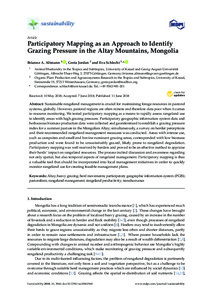| dc.date.accessioned | 2018-08-17T14:00:09Z | |
| dc.date.available | 2018-08-17T14:00:09Z | |
| dc.date.issued | 2018-06-11 | |
| dc.identifier.issn | 2071-1050 | |
| dc.identifier.uri | urn:nbn:de:hebis:34-2018081756065 | |
| dc.identifier.uri | http://hdl.handle.net/123456789/2018081756065 | |
| dc.description.sponsorship | Gefördert durch den Publikationsfonds der Universität Kassel | |
| dc.language.iso | eng | |
| dc.rights | Urheberrechtlich geschützt | |
| dc.rights.uri | https://rightsstatements.org/page/InC/1.0/ | |
| dc.subject | Altay | eng |
| dc.subject | heavy grazing | eng |
| dc.subject | herd movements | eng |
| dc.subject | participatory geographic information system (PGIS) | eng |
| dc.subject | pastoralism | eng |
| dc.subject | rangeland management | eng |
| dc.subject | rangeland productivity | eng |
| dc.subject | transhumance | eng |
| dc.subject.ddc | 630 | |
| dc.title | Participatory Mapping as an Approach to Identify Grazing Pressure in the Altay Mountains, Mongolia | eng |
| dc.type | Aufsatz | |
| dcterms.abstract | Sustainable rangeland management is crucial for maintaining forage resources in pastoral systems, globally. However, pastoral regions are often remote and therefore data poor when it comes to resource monitoring. We tested participatory mapping as a means to rapidly assess rangeland use to identify areas with high grazing pressure. Participatory geographic information system data and herbaceous biomass production data were collected and georeferenced to establish a grazing pressure index for a summer pasture in the Mongolian Altay; simultaneously, a survey on herder perceptions and their recommended rangeland management measures was conducted. Areas with intense use, such as campsites and small and bovine ruminant grazing areas, corresponded with low biomass production and were found to be unsustainably grazed, likely prone to rangeland degradation. Participatory mapping was well received by herders and proved to be an effective method to appraise their herds’ impact on rangeland resources. The process incited discussion and awareness regarding not only spatial, but also temporal aspects of rangeland management. Participatory mapping is thus a valuable tool that should be incorporated into local management initiatives in order to quickly monitor rangeland use for creating feasible management plans. | eng |
| dcterms.accessRights | open access | |
| dcterms.bibliographicCitation | In: Sustainability. - Basel : MDPI. - 2018, 10 (6), 1960, 1-15 | |
| dcterms.creator | Altmann, Brianne A. | |
| dcterms.creator | Jordan, Greta | |
| dcterms.creator | Schlecht, Eva | |
| dc.relation.doi | doi:10.3390/su10061960 | |

